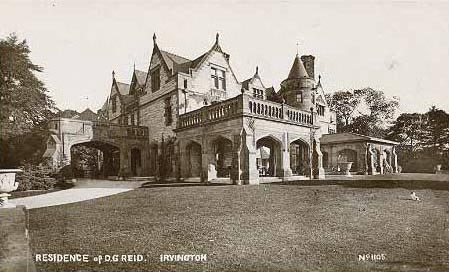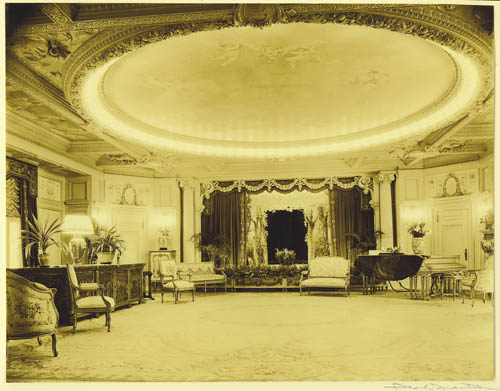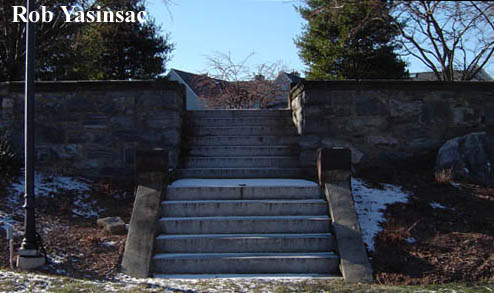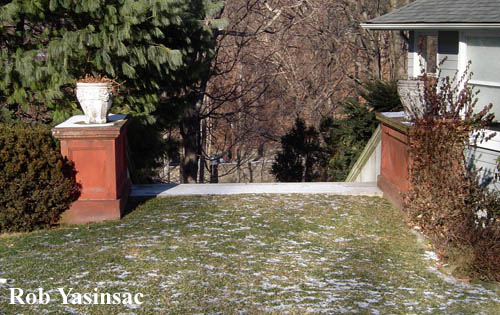
"Residence of D.G. Reid. Irvington."
Richmond Hill

"Residence of D.G. Reid. Irvington."
One of the great lost
houses of the Hudson River was Richmond Hill in Irvington. Many other fine homes
in these river towns have been lost too, some before their time due to fire,
while others were lost to development pressures as the land
became more valuable to real estate buyers than the house itself. Richmond Hill
fell victim to both. This house and several others
in the neighborhood were
lost in the late 1970s and early 1980s and the lands are now occupied by condominiums. Although
the grand castle is gone, many estate relics survive intact.
|
|
ABOVE: 1901 map showing Warner
estate, then named "Osborne Terrace." The two smaller estates
above Osborne Terrace later became part of Richmond Hill. |
The Tudor-mansion, said to have been constructed of imported Scottish granite, was designed by the architect Robert Henderson Robertson and shown in a review of his work in 1896. Its owner was a Dr. Lucien Warner, a graduate of Oberlin College. Warner practiced medicine in New York City, and was successful as a women's corset manufacturer. He donated to his alma mater with his fortune. Turn-of-the-century atlases show the estate as "Cromont" and later "Osborne Terrace." Daniel Gray Reed, "the tin plate king," and a native of Richmond, Indiana, renamed the property "Richmond Terrace" and imported to his new Irvington estate a fence which once surrounded the Centerville Courthouse. Reid and a friend invested in an Indiana tin plate factory. Its success led to them buying other related operations, and eventually consolidating as the American Tin Plate Company (tin plates were used primarily in the manufacture of cans and pots). Later they joined with the United States Steel Corporation, becoming a part of that larger company.

The Ballroom. Photograph courtesy of Oliver Parsons.
Reid sold his estate in 1920, two years after divorcing his second wife, and
five years before his death. Charles W. Mitchell acquired the estate, and in
1931 the property was sold to George Washington Hill, by then the president of
the American Tobacco Company. From the time Hill launched his Lucky Strike
cigarette about 1917, to the time of his death in 1946 at the age of 61, cigarette
consumption in the United States increased from 30 billion cigarettes a year to
over 300 billion cigarettes a year. Hill has been credited with being mainly
responsible for that increase in cigarette use. One obituary stated that Hill
spent 20-million dollars on advertising in 1931, but even during the Great
Depression, he turned a 46-milliion dollar profit that same year.

Where
once peaked gables, massive stone towers and gothic finials were observed,
now only the peaks of the condominiums can be seen at the top of this staircase.
After George Washington Hill sold his Irvington estate, the property changed hands and became a laboratory for North American Philips Company, makers of electronic products, including quartz crystals, electronic tubes, and x-ray equipment. Philips occupied the site from 1944 until 1965, when it moved to Briarcliff Manor. Yeshiva Ohel Shmuel purchased Richmond Hill in 1966. The school educated boys at the high school and college level, and students boarded on the estate. The mansion was partly damaged by a major fire in 1979, after which Yeshiva Ohel Shmuel moved from Irvington. A local architect named Ferdinand Gottlieb purchased the site with plans for 52 condominium units, and demolition of the buildings began in 1979-1980.

Irvington still has many architectural gems - the Octagon House, a domed
Victorian; Nuits, a fine Italianate Revival newly restored; Villa Lewaro, once
the home of Madame C.J. Walker, America's first African-American millionaress,
Strawberry Hill, a haunting Gothic mansion, just to name a few. But here were
once true castles for robber barons and industry giants, and those places are
all gone. And a building the likes of Richmond Hill might not ever be built
again around these parts.
This page and all photographs copyright ©
2005 by Robert J. Yasinsac.
Retransmitting and/or reproducing these images without the permission of Robert
J. Yasinsac is prohibited.
This page posted January 2005. All modern-day photographs taken January 21, 2005.